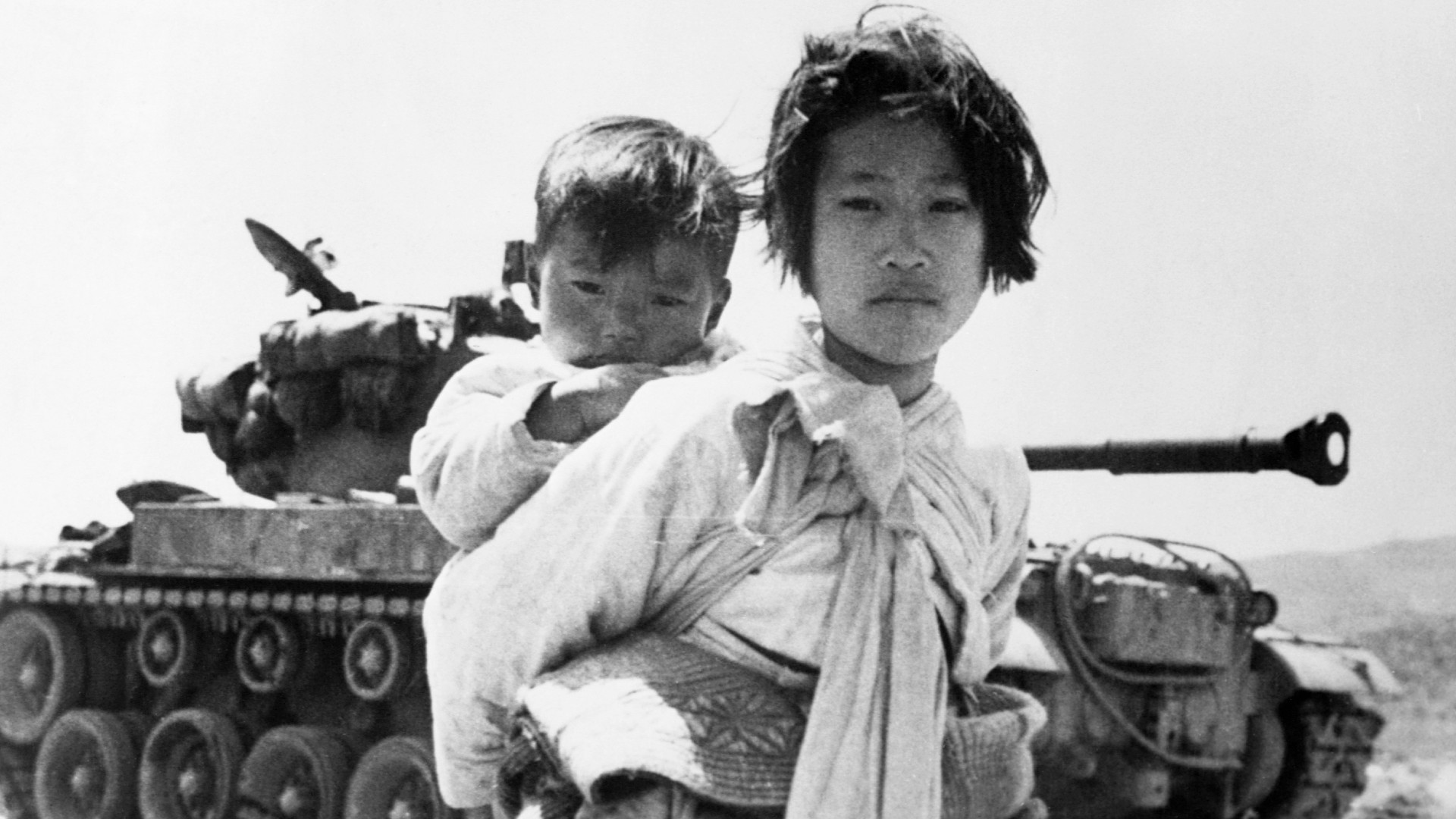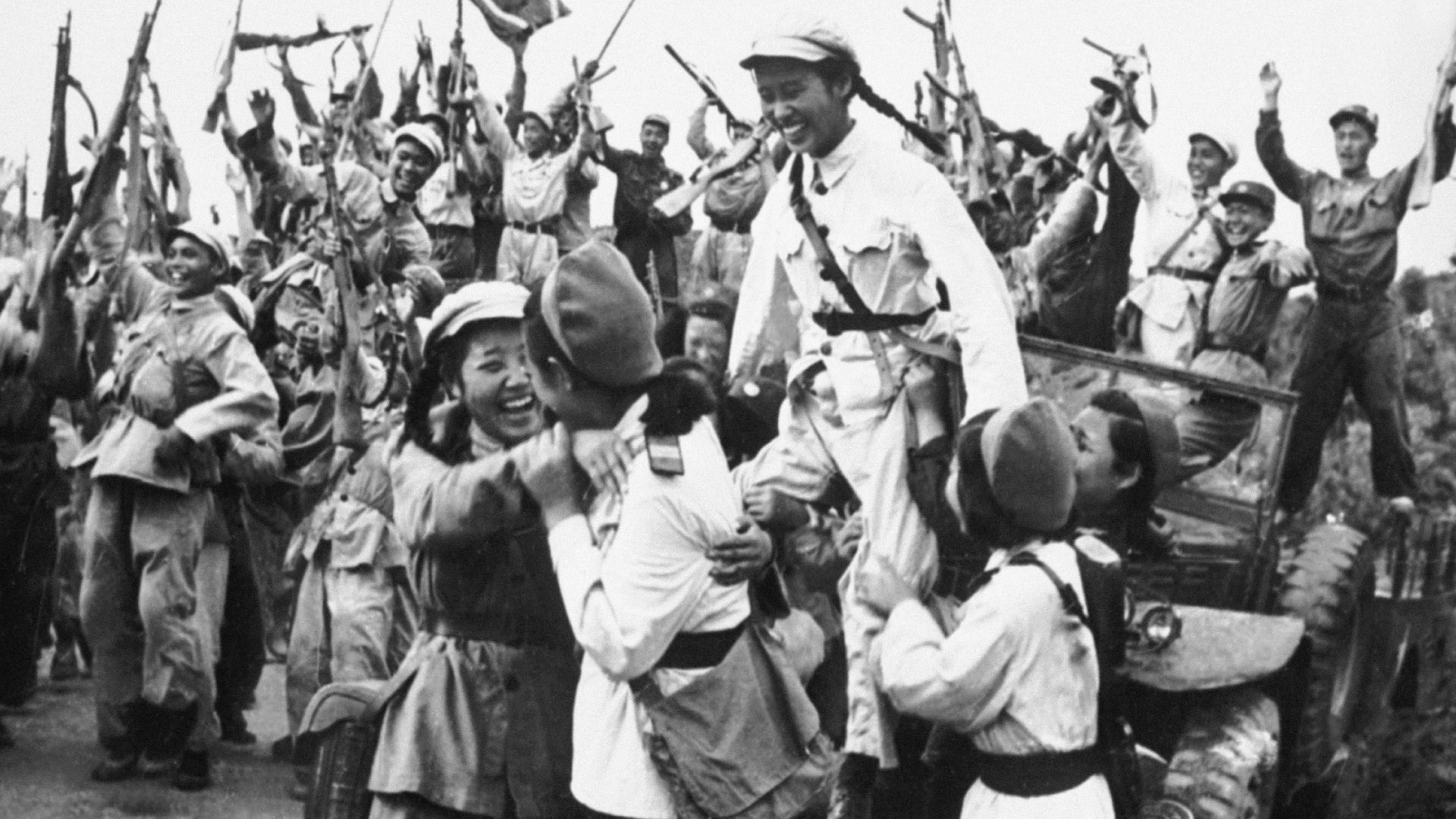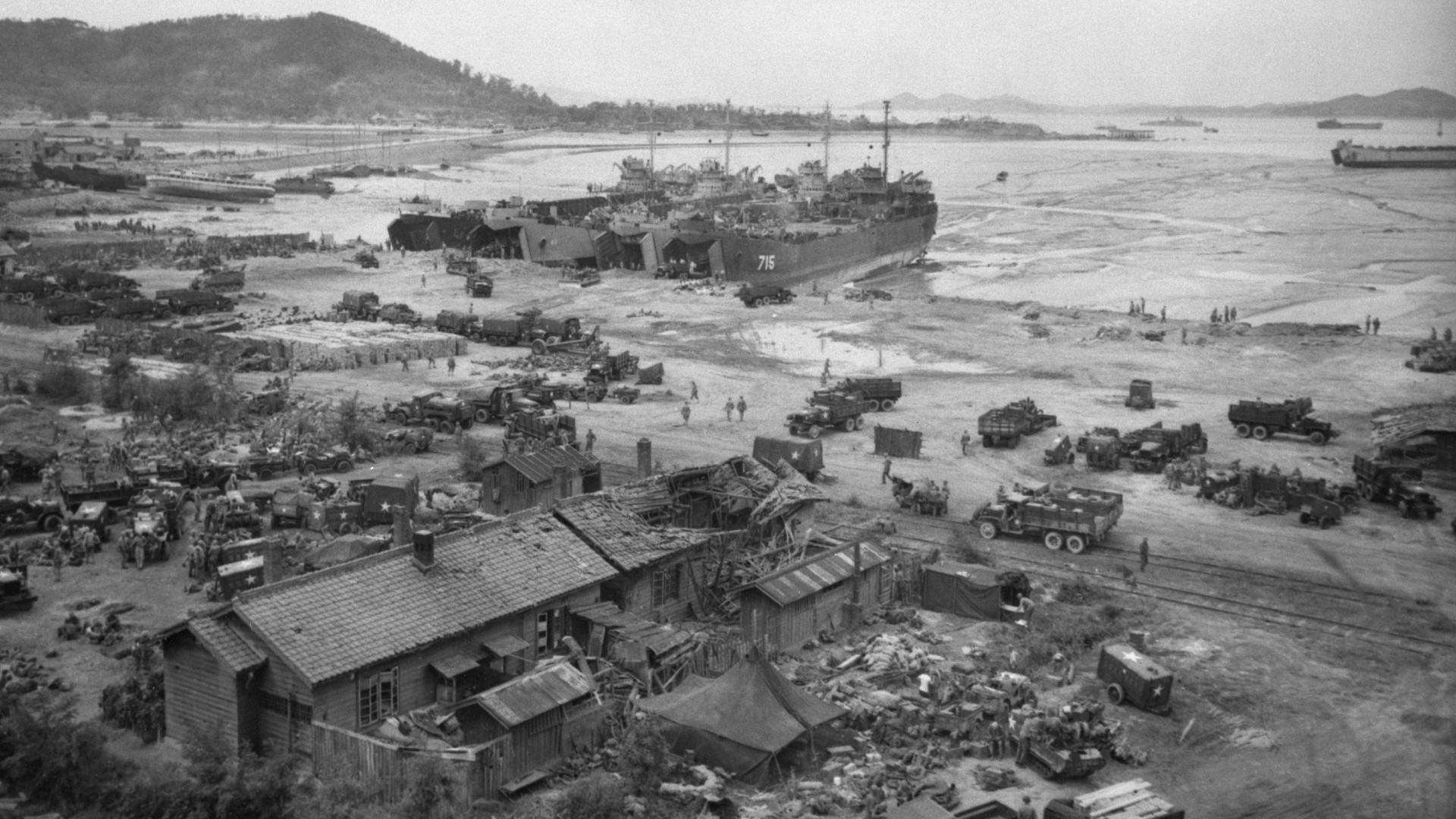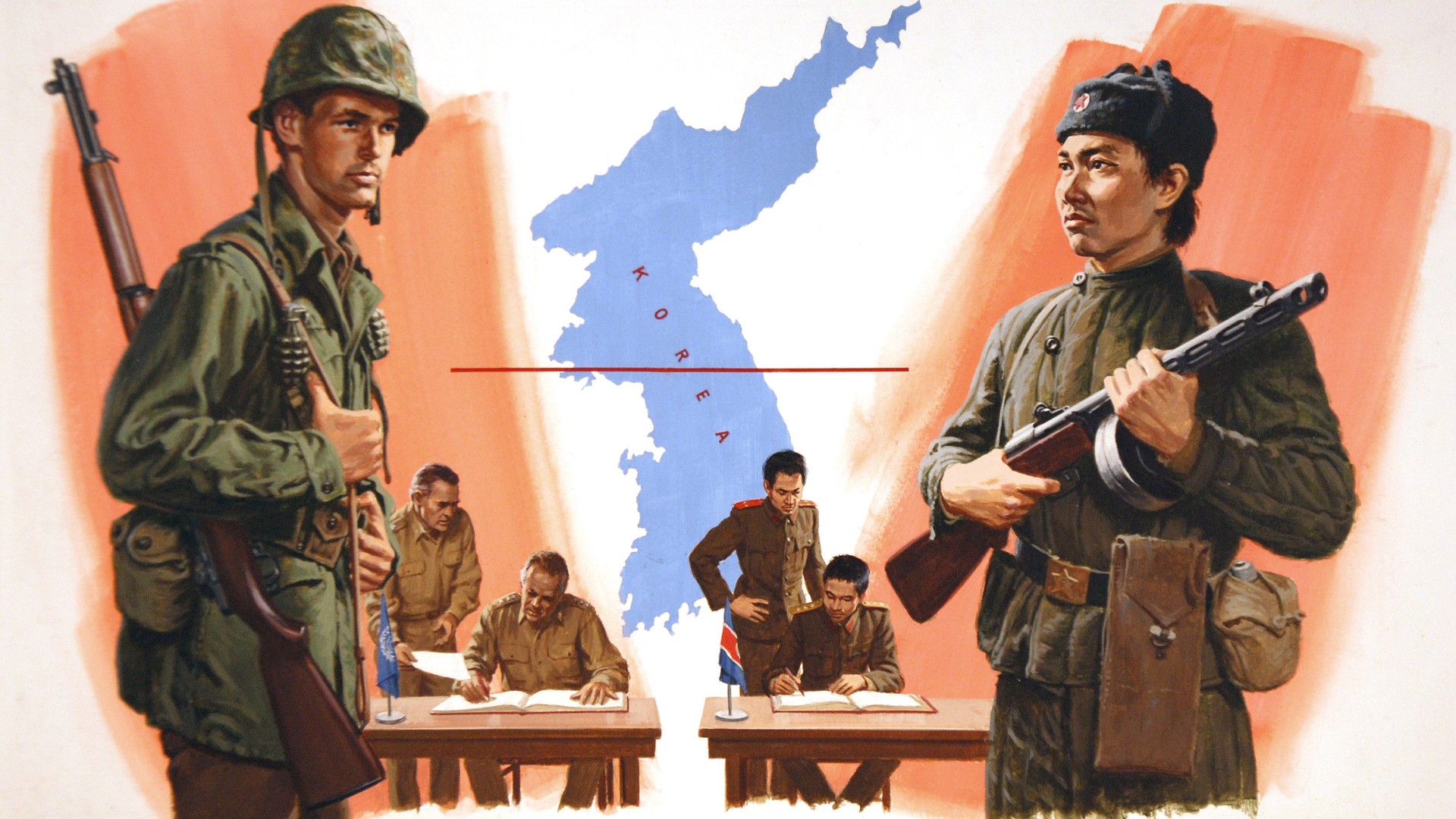Korean War: Causes, combatants and key battles
The Korean War, 1950-1953, began with the communist North Korean invasion of South Korea and was halted by an armistice without a formal peace treaty.

The Korean War began on June 25, 1950 when the communist Korean People’s Army (PKA) invaded neighboring South Korea, crossing the border known as the 38th parallel. The fighting halted with the conclusion of an armistice on July 27, 1953; however, no formal peace treaty has been concluded.
North and South Korea technically remain at war today.
Causes of the Korean War
Shortly after the conclusion of World War II, the Korean Peninsula was divided at the 38th Parallel, and Kim Il-sung returned to his homeland after 26 years in exile. An avowed communist, Kim was the chosen surrogate of the Soviet Union to rule the client state of North Korea. In ostensibly democratic South Korea, Syngman Rhee, a pro-Western career politician, was elected president. From the earliest days of the Cold War, leaders North and South sought to reunify the peninsula under common rule.
"Nobody was satisfied with the division of Korea after World War II, not the Americans, the Soviets, the Chinese, or Koreans themselves," Tom Hanson, retired U.S. Army colonel and author of the book "Combat Ready? The Eighth U.S. Army on the Eve of the Korean War" (Texas A&M University Press, 2010) told Live Science in a telephone interview.
"The Japanese had colonized and exploited Korea ruthlessly for decades. There were Korean expatriates living in the United States, and Syngman Rhee was one of them. Expatriate Koreans also lived in China, and some sought shelter with Mao’s Eighth Route Army during World War II, thinking Mao would lead the liberation of Korea," Hanson said. "Kim Il-sung was anointed by the Soviets as their man in Korea. They gave him military assistance to field a modern army. The Koreans are a proud and patriotic people, South and North, and they would prefer today to have a unified country."
After receiving assurances of support from Soviet Premier Joseph Stalin, Kim Il-sung launched the invasion of South Korea. "According to [Nikita] Khrushchev. Kim Il-sung came to Moscow to seek Stalin's acquiescence in his plans for war, and the North Korean was successful in convincing the Russian that he could gain a speed victory," wrote Max Hastings, author of "The Korean War" (Simon & Schuster, 1988), although he warns against trusting the memoirs of Khrushchev as he replaced Stalin as leader in 1953.
Stalin, however, was convinced that the United States would not intervene. He had miscalculated. President Harry S. Truman petitioned the United Nations Security Council to take action, and on June 27, 1950, Security Council Resolution 83 declared the attack a breach of peace, recommending military assistance for South Korea.
Get the world’s most fascinating discoveries delivered straight to your inbox.
North Korea invades the South

The North Koreans had assembled seven infantry divisions and an armored brigade, up to 90,000 troops, for the invasion, and their early progress was rapid. The defending South Korean Army had been organized to deal with a communist insurgency and possessed no tanks or artillery.
"The U.S. held back aircraft, long-range artillery, and tanks and created a light infantry army with counterinsurgency mission and doctrine. At the time of the invasion, there was no American or South Korean armor in the country, and the last U.S. armed forces had left Korea in June 1949. Eighth Army in Japan was the only U.S. force west of the international date line," Hanson said.
Within three days communist forces had captured the South Korean capital city of Seoul. They steadily advanced with victories at Chuncheon, Chochiwon, and the Kum River. In early July the first American forces, under the United Nations banner, had arrived in Korea. An understrength 500-man detachment from the 24th Infantry Division, Task Force Smith, was outnumbered 10-1 and overwhelmed at Osan. By the end of July, the key towns of Taejon and Yongdong had fallen to the communists as the U.S. 1st Cavalry and 25th Infantry Divisions arrived in Korea. The 1st Marine Provisional Brigade deployed in August.
In early August, U.N. forces under General Walton H. Walker established a defensive line around the vital port of Pusan on the East China Sea. Encompassing 140 miles, the Pusan Perimeter was the last line of defense against the communist onslaught in South Korea. Initially,the U.N. troop complement was insufficient to defend the entire perimeter; however, Walker issued his famous "stand or die order," and the line held against repeated North Korean assaults that eventually eroded their combat efficiency as supply lines were stretched thin.
Pusan was a heroic effort, and I would call it desperate. General Walton Walker does not get the credit he deserves for managing that fight. He had to defend an extensive perimeter that was being probed at virtually every point by tough people who, by that time, had significant combat experience against the Americans. He was fighting on a shoestring while holding the line," Hanson said.
Battle of Inchon

While General Walker’s embattled Eighth Army held on at Pusan, U.N. reinforcements deployed rapidly to the threatened area, and General Douglas MacArthur, supreme commander of U.N. forces in Korea, planned an amphibious counterthrust at the port of Inchon in the northwest of the Korean Peninsula, 25 miles from Seoul. The operation was fraught with risk, not least because the tides fluctuated up to 36 feet within the confines of the harbor.
Nevertheless, MacArthur knew that a successful landing of the U.N. X Corps could sever North Korean communication and supply lines to the south and possibly cut off thousands of enemy troops that had threatened Pusan for the previous two months. On Sept. 15, 1950, MacArthur launched Operation Chromite, and eventually 75,000 troops of the U.S. 1st Marine Division and the U.S. Army’s 7th Infantry Division came ashore. The landing at Inchon was a resounding success, as the North Koreans were caught by surprise and several counterattacks were beaten back.
"The marines landed mostly unopposed, but then slogged through a deadly gauntlet before Seoul finally fell at the end of September. Against this the North Koreans could do nothing; Kim Il-sung placed about two thousand poorly trained troops to defend the harbor, and for unknown reasons, failed to mine the port," wrote Bruce Cumings, author of "The Korean War: A History" (Modern Library, 2011).
"I think MacArthur was extraordinarily lucky at Inchon,' Hanson said. "He understood that the North Koreans had shot their bolt with their offensive and were tied up at the Pusan Perimeter. An assault so far from Pusan was a calculated risk, but he knew that if he kicked the door open the whole house would fall in on itself."
The Inchon landings coincided with an Eighth Army breakout from the Pusan Perimeter, and the resulting North Korean withdrawal became a rout with an estimated 35,000 communist soldiers killed or captured. Seoul was liberated in late September, and the momentum of the U.N. offensive steadily grew. U.N. troops crossed the 38th parallel into North Korea, captured the capital of Pyongyang on 19 October, and reached the Yalu River, the frontier with Chinese Manchuria.
Battle of Inchon Map
China enters the war
After the victory at Inchon, General MacArthur discounted ominous signs of Chinese intervention in Korea, even after the government of Mao Tse-tung had issued repeated warnings. Although some Chinese troops had been encountered during the drive to the Yalu, their presence was a mere foretaste of the large military force that was standing in the wings.
On Nov. 15, 1950, Mao sent 300,000 Chinese troops that caught frontline U.N. units by surprise and overwhelmed them. MacArthur’s quest to defeat the communists and unify Korea under democratic rule was now an impossibility. Three days after the massive Chinese offensive commenced, he cabled President Truman: "We face an entirely new war." Truman had warned MacArthur to avoid operations that might provoke the Chinese, but those warnings had gone unheeded.
U.N. forces were sent reeling. Outnumbered four to one, 30,000 U.N. troops surrounded at the Chosin Reservoir in horrific cold weather managed to fight their way out of encirclement, the survivors reaching the port of Hungnam, where they were evacuated with the rest of the X Corps. The Eighth Army retreated from northwest Korea as well, and communist forces again occupied Seoul.
MacArthur isn’t worried about the Chinese until Chinese soldiers are on the battlefield in early November, but then he wants the military assets to convince the Chinese not to be involved. After the disaster at the Chosin Reservoir, MacArthur wants local release authority for the use of nuclear weapons and the introduction of nationalist Chinese troops. Truman says, 'Hell no!'," Hanson said.
By the spring of 1951, Truman and MacArthur were at loggerheads over the conduct of the war in Korea, and Truman relieved MacArthur of command in April, replacing him with General Matthew Ridgway.
Fighting to a stalemate
Meanwhile, after weeks of heavy fighting, communist forces had absorbed tremendous casualties, and their advance had ground to a halt following their defeat in February 1951 at Chipyong-ni, considered a turning point of the war by Jamie l. Hickman, author of "Turning Korea Around: An Analysis of Mission Command at Chipyong-Ni," for the Journal of Defense Management.
General Walker had been killed in an automobile accident in December 1950, and Ridgway had taken command of Eighth Army. He further set about restoring the morale of the U.N. forces and launched successful counteroffensives that drove the communist forces back and once again liberated Seoul.
Once the U.N. forces had regained the initiative, the enemy was pushed back to the vicinity of the 38th parallel. Ridgway and Eighth Army commander General James Van Fleet then begin to pursue a strategy with both offensive and defensive components. Although they had blunted the communist offensive and regained tremendous amounts of lost territory, they did not possess the strength to launch a decisive, war-winning second invasion of the North.
U.N. strategists pursued limited attacks to extend their lines and consolidate positions as they were able while remaining vigilant against a potential major communist counterattack and minimizing the probability of taking heavy casualties.
For the next two years, the Korean War was fought to a stalemate. Peace negotiations began at Kaesong in July 1951, but the Chinese and North Koreans broke off the talks in August. In the autumn of 1951, the war was punctuated with fierce fighting at otherwise nondescript points along the opposing lines. They gained such rueful names as Bloody Ridge and Heartbreak Ridge. For seven months beginning in June 1952, soldiers fought and died for control of high ground that came to be known as Old Baldy. After five separate battles had been fought there, the defending U.N. commanders deemed Old Baldy and nearby Pork Chop Hill not worth the price of additional casualties and abandoned both.
Truce in the fighting

In October 1951, armistice negotiations resumed at the village of Panmunjom . However, the pace was glacial. Points of contention included not only the occupation of territory, but also the repatriation of prisoners of war captured by U.N. forces. "Many of the original Chinese army troops were ethnic Koreans, and they did not want to be repatriated to China," Hanson said, "and this became a humanitarian problem for Truman."
To resolve the prisoner exchange issue, a Neutral Nations Repatriation Commission was constituted and chaired by General K.S. Thimayya of India. A Demilitarized Zone was established, and it remains in effect today. The armistice agreement, effectively a cease-fire, was signed at 10 a.m. on 27 July 1953, and the two sides were allowed three days to withdraw to positions that were 1.25 miles from the cease-fire line.
In three years of fighting, U.N. forces had lost nearly 171,000 killed, 566,000 wounded, and 32,600 missing, while communist losses are not confirmed but believed to approach 900,000 killed, 687,000 wounded, and more than 145,000 missing. Estimates of civilian casualties are as high as three million. In the nearly 70 years since the fighting ended, border incidents, defections, and provocations have occurred on numerous occasions.
Today, the Korean Peninsula remains divided, and only recently has the possibility of a real peace treaty formally ending the war resurfaced. North Korea is largely isolated from the rest of the world. Its third-generation leader, Kim Jong-un maintains a firm grip on the people and has at times destabilized the region with threats of nuclear weapons and renewed hostilities. In contrast, South Korea is a prosperous, industrialized nation.
In 1995, the U.S. government dedicated the Korean War Veterans Memorial to the nearly six million Americans who served during the conflict and the 36,000 who died. The U.S. military currently maintains an active presence of approximately 30,000 troops in South Korea.
Additional resources
If you want to learn more about U.S. military involvement in the Pacific and Asia then you'll definitely want to read about the Battle of Iwo Jima.
An estimated 36,000 Americans died in the Korean War, but what was the deadliest day in U.S. history? We have the answer for you.
Bibliography
- Truman Library
- Department of State: Office of the Historian
- U.S. Army Center Of Military History
- National Museum of the Marine Corps
- CBS News: The Korean War Timeline
- "Oxford Companion to Military History" edited by Richard Holmes (Oxford University Press, 2001)
- Dwight D. Eisenhower Presidential Library
- "Turning Korea Around: An Analysis of Mission Command at Chipyong-Ni," by Jamie l. Hickman, the Journal of Defense Management
- "The Korean War: A History" by Bruce Cumings (Modern Library, 2011)
- "The Korean War" by Max Hastings (Simon & Schuster, 1988)
- "Combat Ready? The Eighth U.S. Army on the Eve of the Korean War" by Thomas E. Hanson (Texas A&M University Press, 2010)
- "The Korean War: An International History" by William Stueck (Princeton University Press, 1997)
- "The Korean War: An International History" by Wada Haruki (Rowman & Littlefield Publishers, 2018)

Michael E. Haskew, who has been studying military history for more than 25 years, is the Editor of WWII History magazine and The World War II Desk Reference with the Eisenhower Center for American Studies. He is also the author of several books, including the "West Point 1915: Eisenhower, Bradley, and the Class the Stars Fell On," "Appomattox: The Last Days of Robert E. Lee's Army of Northern Virginias," and "Tank: 100 Years of the World's Most Important Armored Military Vehicle."


